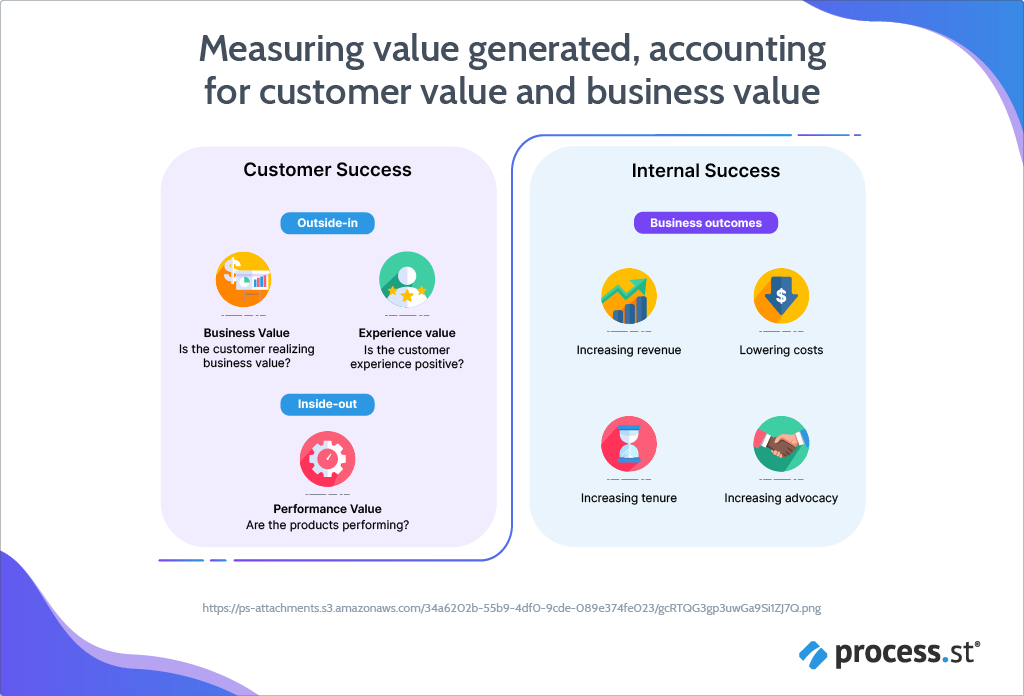
Companies with a customer-centric account health scoring system enjoy a 95% increase in customer retention.
To be more customer-centric, you need an account health scorecard that takes a holistic approach to measure your health and your customers’ health. In this Process Street article, we’ll show you how to do that.
We’ve produced your ultimate workflow guide to help you create this account health scorecard. This template is free for you to use from your Process Street account (you can sign up to create your free account here). This workflow guide has been produced based on the Customer-Centric Digital Transformation report by Deloitte.
You’ll also learn the key benefits you’d expect from taking this holistic approach to measuring an account’s health, with two real-life case studies.
This article is structured as follows:
- Create an account health scorecard that measures customer and business success
- Why you need an account health scorecard
- Case studies: Applying the account health scorecard approach in real life
Create an account health scorecard that measures customer and business success
Software as a Service (SaaS), the Internet of Things (IoT), and the rise of the subscription economy are forcing companies to take a serious look at revenue from existing customers. Increasingly, business success relies on retaining and growing revenue from an organization’s existing customer base – or in other words, making sure accounts are healthy.
But how do you quantify the health of your customers’ accounts?
What you need is a way of articulating your customer’s outside-view of value, a company’s inside-out product view of value, and business outcomes.
The image below illustrates how you can quantify customer health, encapsulating both the company and the customer benefits. The aim is to bridge the gap between customer and internal business success.

Based on the above framework, you can create an account health scorecard that accurately assesses both customer health and your health. The scorecard is designed to alert the relevant business functions of a problem before a customer identifies that problem.
To summarize, your scorecard should:
- Accurately capture the customer’s target objectives, target outcomes, and progress along their value realization path.
- Provide an advanced visual aid for users to understand product performance based on usage and business value creation.
- Track potential and emerging areas of concern and red-flag these as issues.
- Continuously measure the health of an account over time.
Scorecards follow a consistent, data-driven methodology. This means you can go beyond making account assumptions. With a scorecard, you can measure the impact of your customer success efforts, and compare these to benchmark measures across your customer’s portfolio.
Taking all of this into account, we at Process Street have created a workflow guide to help you create a holistic account health scorecard.
Account Health Scorecard Checklist Workflow
Our Account Health Scorecard Checklist Workflow has been designed from Deloitte’s Customer-Centric Digital Transformation report. All you have to do to access this workflow is create your free Process Street account, open the workflow, and get started.
Process Street is your business process management solution to make complicated, multi-step processes easier and faster
according to G2 Reviews.
In this instance, we’re talking about making the production of your account health scorecard both easy and effortless. Our workflow is designed to be run by customer success representatives but also coordinates tasks between the CS rep and a customer success manager. Run this workflow on a monthly basis for the continual assessment of an account’s health.
Click here to access our Account Health Scorecard Checklist Workflow for free!
Key checklist features:
- File Upload and Approvals: You’ll be asked to upload the account scorecard you produce using our File Upload feature. Your manager is then notified that your scorecard is ready for assessment, and can jump in and accept/reject (with comments) as required using our Approvals feature. This gives an extra layer of quality control.
- Stop Tasks: Stop Tasks ensure the required steps for creating an accurate scorecard are completed in the correct order.
- Role Assignments: Use our Role Assignments feature to assign your supervisor to the approval task. Your supervisor will be automatically notified of the upcoming approval action required.
- Form field: Use our Form Fields feature to document the relevant account information recorded to produce your account health score card. This keeps account-related relevant information in a single location, to be accessed by anyone at any time on your team. Data entered into Form Fields can also be kept private, or limited to certain people/roles.
Why you need an account health scorecard
Like I mentioned, companies with a customer-centric health scoring system enjoy a 95% increase in customer retention. With this in mind, the account health scorecard you produce using our Account Health Scorecard Checklist Workflow will transform CS and align business functions to better serve your customers. For instance, you can think about how cutting business costs will impact customer satisfaction (CSAT), a fundamental KPI used to determine customer experience.
The benefits of using our account health scorecard workflow, however, go beyond customer retention improvements. Listed below are other important benefits to note:
- Better strategic planning: You can think about the cause-and-effect relationships between different strategic options. You’ll be able to identify performance outcomes, key enablers or drivers of future performance, and obtain a complete strategic picture. Our Account Health Scorecard Checklist Workflow invites you to strategize to improve KPI measures across CS and internal business functions.
- Improved communications and execution of strategy: You can gain a one-page picture of strategy, making it easy to communicate both internally and externally. If a team member wants to know where a customer is at, what they want to achieve, their health, and strategies to improve their health, that team member can jump into the customer’s account health scorecard – documented in Process Street – to find this information out.
- Better information management: An account health scorecard helps organizations design key performance indicators for their various strategic objectives. This means companies can measure what matters.
- Improved performance reporting: Guides the design of performance reports and dashboards.
- Better organizational alignment: Use an account scorecard to better align your organizational structure with strategic objectives to execute a plan well. Organizations need to ensure that all business units and support functions are working towards the same goal. Cascading the balanced scorecard into those units helps the business functions do that, linking strategy to operations.
- Better process alignment: Improved alignment helps organizational processes such as budgeting, risk management, and analytics. This is especially true when using Process Street to manage your business processes. Different processes are easily linked together using our workflow-run links and process automation features. With Process Street you’ll create a network of business operations, linked and running together in parallel.
Case studies: Applying the account health scorecard approach in real life
To fully appreciate the benefits of using our account health scorecard, let’s apply the concept to real-life.
In these two case studies we’ll take a look at the cloud-based construction management solution Assignar and e-commerce startup selling second-hand designer products online, Cudoni.
Case study: How Assignar calculates their account health score

Assignar measures product performance along with customer-relationship KPI measures to calculate the health of an account. To identify accounts at risk, Assignar uses the following main KPI metrics:
- Reduction in usage;
- No/small usage of key features;
- Too many or no support conversations;
- Low survey score (NPS, CAST, etc);
- Sudden stop in references/speaking engagements;
- Overdue invoices;
- A combination of the above.
The above KPI metrics used by Assignar give a good measure of customer success. However, they are missing an important step. The KPI metrics used will take into account product performance and customer experience.
Assignar does not include KPI metrics to measure internal business success and business value. Assignar would benefit from using a holistic account health scorecard approach, one that considers business success and value. Without these measures, Assignar doesn’t know what CS activities are generating the best return. Customer success demands a fine balance between meeting your customer’s needs while also delivering strong business returns. Without measuring the two together, how can Assignar prioritize accounts and activities accordingly?
Case study: How Cudoni calculates their account health score

While interning at Cudoni, I helped formulate strategies to improve customer retention. To determine customer health, we used common KPI measures that gauged CS satisfaction.
Cudoni focused on delivering an excellent service and experience for all clients. However, I often focused on delivering that experience regardless of whether the client returned a high business value. With limited time, I would have benefitted from a more holistic approach to customer success, i.e. prioritizing clients with high business value. Like Assignar, if I had used an account health scorecard that measures customer success along with internal business success, I’d have more of an idea of how account impacts business outcomes, and strategized my efforts accordingly.
Use an account health scorecard to take a holistic approach
To move towards customer-centricity, it goes without saying that you need to be able to measure performance using a customer-centric approach.
An account health scorecard is a visual aid to help you determine the health of your accounts and identify areas of concern. Using our Account Health Scorecard Checklist Workflow, you can measure customer success along with internal business success to produce a scorecard that is customer-centric and holistic.
Create your free Process Street account here and start using our Account Health Scorecard Checklist Workflow today!
For more information on how to improve your customer success function, read:
- The Secret to Success: Process Street’s Customer Success Team Tell All
- Complete Guide to Customer Success for SaaS Companies
- Customer Success 2.0: The Essential Software Stack to Execute McKinsey’s Model
- 5 Tips to Make Your Customer Success Vectors Actual Vectors (KSIs Not KPIs)
- How to Manage a Successful CS Transformation to Be More Customer-Centric
How do you measure the health of your accounts? Do you use an account health scorecard? What challenges and successes have you faced using this method? We’d love to hear from you, please comment below!







 Workflows
Workflows Projects
Projects Data Sets
Data Sets Forms
Forms Pages
Pages Automations
Automations Analytics
Analytics Apps
Apps Integrations
Integrations
 Property management
Property management
 Human resources
Human resources
 Customer management
Customer management
 Information technology
Information technology



Jane Courtnell
Hi there, I am a Junior Content Writer at Process Street. I graduated in Biology, specializing in Environmental Science at Imperial College London. During my degree, I developed an enthusiasm for writing to communicate environmental issues. I continued my studies at Imperial College's Business School, and with this, my writing progressed looking at sustainability in a business sense. When I am not writing I enjoy being in the mountains, running and rock climbing. Follow me at @JaneCourtnell.